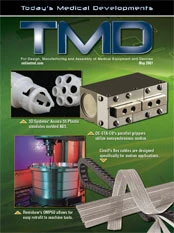
Today's Medical Developments' Editor- in-Chief Tom Grasson opened the Mori Seiki-sponsored WESTEC Cutting Tool Roundtable on March 26 by saying, "I think we've got the cream of the crop here." Having an array of cutting tool companies gathered together in one room talking about the industry was a bold initiative. Even so, Grasson intended on keeping the discussion "informal, yet informative".
Each contributor was given topics for conversation prior to the roundtable, which gave them time to preview the questions. With each company sending the best of the best, these topics were sure to be covered from every angle. Participating companies included: Big Kaiser, Criterion Machine Works, Hannibal Carbide Tool, Iscar Metals, Kennametal, Komet of America, Niagara Cutter Corp., New Tech Cutting Tools, Sandvik Coromant, Seco Tools, Stellram and Mori Seiki.
TMD:How has the cutting tool industry changed over the last five years?
Jack Burley, Big Kaiser: Over the past five years, coming out of the 2001 recession, I think that everyone has been in recovery mode. As far as the technical aspect of how it has changed, I think more and more companies are trying to address the needs of nickel-based alloys.
Gary Vanderpol, Criterion Machine Works: What we're trying to do on the boring tool side is create a stable platform for new inserts that can run at higher speeds and feeds.
TMD: What is the single most important issue facing the tool industry today?
Dennis Dewey, Hannibal Carbide Tool: We've got to continue to increase our technology knowledge and implement our findings. Cutting tool manufacturers need to spend as much as possible on R&D.
Trace Jacobs, Iscar Metals: Much of what we're dealing with right now emphasizes stopping the flow of manufacturing that is leaving the country. We are working to be more proactive in developing new tools, niche products, things that will help our customers find a faster productivity gain in their facility, to help them keep their work in the U.S.
Mike Parker, Seco Tools: It's the best educated that can actually use the new techniques and developments that are available. Custom education can gain productivity.
Dave Watson, Stellram: One of the challenges facing the cutting tool industry is the vulnerability of raw materials. This is something that could impact the industry, and I think we need to watch and deal with it.
François Gau, Kennametal: The thing we find out most when we get to our customers is lack of available resources; we've got to fix that as an industry. The imbalance of mechanical engineering graduates out of the U.S. versus the rest of the world is growing.
TMD: Looking at the challenge of new materials, is the cutting tool industry prepared to effectively cut new materials such as 5553 Titanium, composites, CGI?
Gau: You can cut those materials; there's little magic to it. Titanium 5553 is still titanium and you can cut it. It is not an impossible task. Can you effectively cut those materials would be my preferred question. And my answer to this is: not yet, as a standard product off the shelf.
Watson: I think it's the way you approach cutting the metal, it's the substrate, the geometry, the coatings, all those combinations have to be formulated for these new materials.
Bill Sebring, Niagara Cutter Corp.: Materials such as Titanium 5553 are increasing in applications. Expectations need to be clearly defined when developing milling applications for materials such as Ti 5553 and composites. Ti 5553 can be effectively machined through proper testing, development and documentation.
TMD: As materials get harder to cut, do you view grinding as a threat to the cutting tool industry? Why or why not?
Carsten Lehmann, Komet of America: For certain applications, grinding can be an option. This can be costly, when compared to cutting tools, because grinding typically requires a special dedicated machine and an additional setup if other operations are required. Griding can be appropriate for applications like facing and turning, but for other applications, such as holemaking, cutting tools provide probably the only viable solution.

Rober Troller, Sandvik Coromant: For cutting tool companies that have R&Ds and are willing to invest in those R&Ds, we see it as an opportunity, not as a threat.
TMD: As machine tools become capable of supporting grinding, milling and turning, do you anticipate migration from one type of tooling to another?
Greg Hyatt, Mori Seiki: As the machine tool becomes more flexible, more agile, and can support grinding as well as turnonly competing with each other, but also with manufacturers of grinding tools. His torically, once the customer bought a ma chine, they were locked into a limited range of processes, but that's going to change. The customer is going to have the ability to move back and forth between grinding, milling and turning. My speculation is that it will create opportunities both for you and for the grinding wheel manufactures.
TMD: What are your views on coated tools; will they continue to grow in popularity?
Sebring: Absolutely. Thin film coatings are absolutely important in being able to efficiently machine materials such as titanium- based and nickel-based alloys.
Vanderpol: Carbide tools—whether it's a solid, round or insert—are definitely going to continue from what we see in our forecasting.
TMD: As cutting tool manufactures, why is it important to build and maintain a relationship with machine tool manufacturers?
Burley: Developing a good relationship with the machine tool builders is just going to make a better process for the customer in the end.
Gau: To add to this, I want to put the customer into the picture. Working with some of our customers, we have found some interesting trends that can be applied into new toolings.
Hyatt: Sometimes the more creative breakthroughs require joint work between the machine tool builders and the cutting tool manufacturers. Only by working together can we jointly bring the solution to the customer.
TMD: How receptive are end users to allowing cutting tool trials on the manufacturing floor? What types of problems are most often encountered?
Dewey: We have shops that will call us and want us to come in to try to help them, and we're more than willing to do it. Often if it's a matter of production, they can't get enough production out to meet the current high demand, and therefore it is difficult to stop production, break the setup, tear down and see if our tools are going to do any better. It can be a double-edged sword.
Jacobs: People are not very receptive to letting us on their floor because they are busy, they're very, very busy, and because they're busy they want us there—it is a double-edged sword.
Steve Swift, New Tech Cutting Tools: If a customer trusts you and you've tested with them before, you've proven that you can show them results, even when they're busy. It's that element of trust—you can't go in and fail.
TMD: What manufacturing sectors will have a big impact on the cutting tool industry?
Parker: I think that mentioning aerospace and medical is a good testament to new materials.
Gau: We also see the rail industry booming in certain parts of the world. Energy is definitely another area that we watch very carefully. It's still pulling significant global demand.
Swift: We're seeing a big insurgence of wind mills. We're also seeing solar farms, where they are using solar panels. And like it or not, I'm sure there's going to be an insurgence of nuclear reactors.
TMD: Will manufactures see new activity in terms of new tools over and above what they currently see?
Sebring: In endmill applications, requests for new or application specific cutting tool designs occur daily. The specialty or high performance market will drive the development of these cutting tool designs. Application specific cutting tools are where true value is added by allowing the highest level of performance.
Burley: I think we as cutting tool manufactures have to coordinate ourselves with the machine tool builders and the customers to bring the system together. I think you're going to see more of that team building in the future.
TMD: Within the cutting tool industry, what changes can we expect to see in the next three to five years?
Vanderpol: You're going to see a greater change on the technology side, development of new cutting tools and things like that.
Dewey: I think manufacturers need to ad index be able to respond to our end users. There are not as many technical people coming into the business, and I think manufacturers are going to have to pick up some of the "slack".
Gau: In the next three to five years, I think there's going to be improvements to the performance of the cutting tool. With all the work we do competing against each other in this group here, it'll be very good for the customer.
TMD: From your individual perspectives, is there anyone who would like to make a final comment? Something you would really like our readership to know?
Parker: I'd like the readership to not focus on the cost of the insert, but on the value of the component.
Jacobs: The customers need to open up their doors and be responsive to the fact that we are basically creating engineering resources that bring deliverables to their door that can make them more money. This is what we do.
Watson: I think with the new materials that are hitting the marketplace, the customers, as they start to work with these materials, have to realize that they can't do things the same way that they used to. They have to understand that they have to try something new.
Throughout, interesting questions were raised and perhaps even more interesting responses were given. Although these companies find themselves in head-tohead competition on the work floor, they put their minds together, providing insight into the cutting tool industry.
Get curated news on YOUR industry.
Enter your email to receive our newsletters.
Explore the May 2007 Issue
Check out more from this issue and find your next story to read.
Latest from Today's Medical Developments
- Roundup of some news hires around the manufacturing industry
- Mazak’s INTEGREX j-Series NEO Machines
- The Association for Advancing Automation (A3) releases vision for a U.S. national robotics strategy
- Mitutoyo America’s SJ-220 Surftest
- #56 - Manufacturing Matters - How Robotics and Automation are Transforming Manufacturing
- STUDER looks back on a solid 2024 financial year
- HANNOVER MESSE 2025: Tailwind for industry
- Find out the latest developments in tool path strategies for machining





